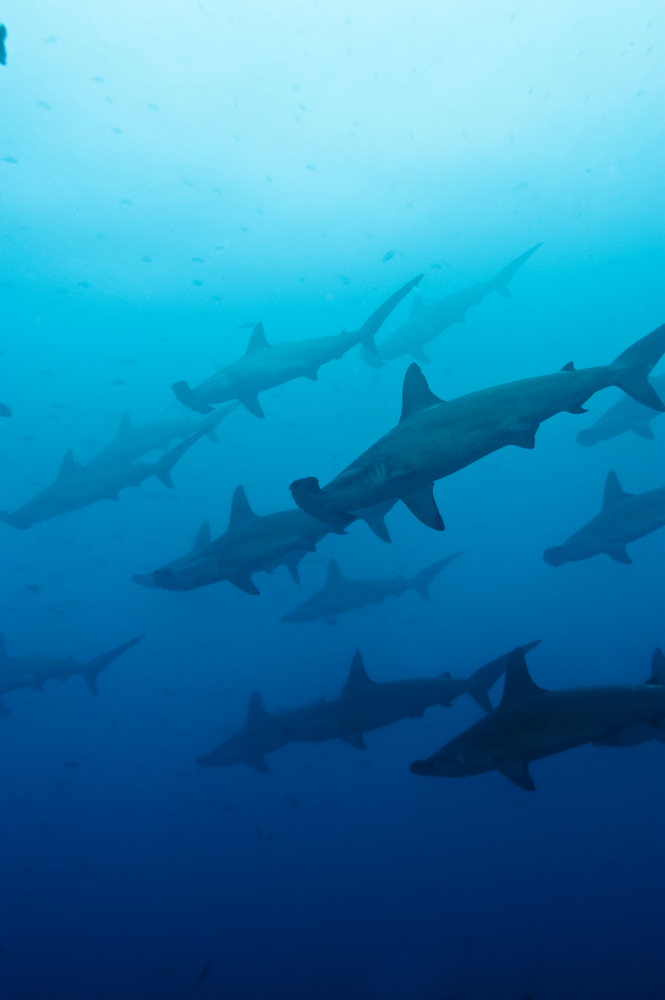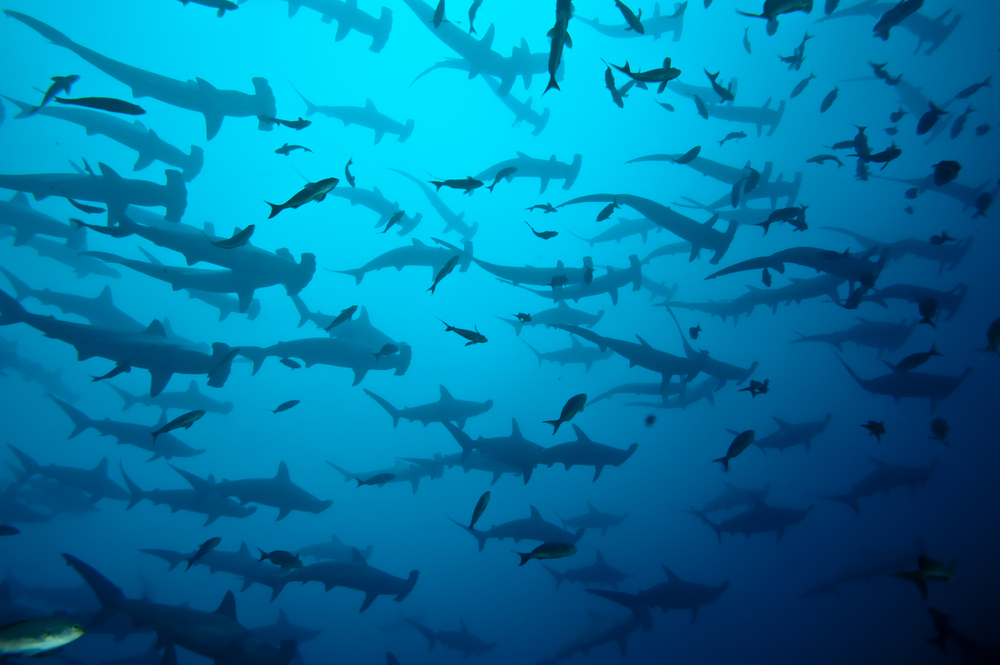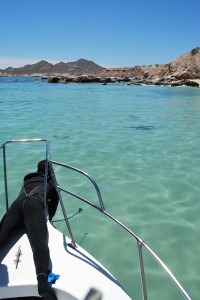
Last year, I reported a story about sharks disappearing in the Sea of Cortez. The story deals with one little spot near the bottom of the Baja Peninsula called El Bajo. El Bajo is famous for two things, I suppose. One, it’s the site where scientists discovered a now-famous behavior in which hammerhead sharks from all over the ocean gather and circle in an amazing slow-motion mating dance (see above and below).
Nowadays we know that there are other spots where this happens, the Galapagos, Guadalupe Islands, and a few others. But the second thing that El Bajo is (or should be) famous for is this: today there are no more hammerheads there. All of them are gone. The story is now on the cover of Discover magazine (marking a sharp divergence from my recent streak of NOT publishing stuff) so I won’t ruin it by telling you why. But in the story I ran across this rather interesting fact. Never in the history of humans-screwing-with-the-world have we managed to send an open-water ocean species into extinction.

Not that we haven’t tried, mind you. Blue fin tuna, sturgeon, and now many types of sharks are at less than ten, five, even two percent of historic levels. Thirty percent of sharks are threatened or near-threatened with extinction (and those are just among the ones we know about, not the big, exciting species for which we have no idea). These are slow-growing species that breed late in life and don’t take well to being considered exotic food. Yet after decades of us trying to wipe them out, they are still clinging to the bottom rung with their scaly little fins.
All the underwater species have managed to put in the extinct column are either freshwater species or else highly limited ocean species. Things like greenback and yellowfin cutthroat from Colorado and the ash meadows killifish of Nevada (overfished and replaced by invasives) were trapped in lakes and streams. The Chinese river dolphin was similarly limited in movement.
This raises the question, is it even possible to wipe out an ocean species? It may be the answer is no. It turns out many people think that because fish species live in massive, complex 3-D world, we can never get all of them (the African savanna is apparently 2-D).
This “extinction-proof” model is surprisingly widespread. Scientists like Ray Hillborn at the University of Washington argue that many species are actually most productive at 20 percent of historic levels and can go even lower without threatening the species (most define a “collapsed fishery” as less than 10 percent of historic numbers). But these models often don’t take into account slow-growing sharks or the developing world, which dominates the tropics.

Nick Dulvy, a leading shark expert at Simon Frasier University says it’s totally possible and that the question is more generational than scientific. In the past, government fish experts were expected to work for the fishing fleet, ensuring that they had a healthy catch. But in recent years (perhaps since the shocking collapse of the Atlantic cod in the 1990s), policy has switched to protecting the fish themselves.
“Now they’re working for the species and it’s a really difficult transition for older scientists. Some guys just cannot get their head around it,” he says. “This age gap thing is very, very real and widespread. I see it in older IUCN scientists. They just can’t imagine that things go extinct.”
Most of the younger scientists I talked to for my story had no problem imagining an open ocean species going extinct, despite the fact that it’s never happened. Most older scientists said such a thing is impossible and used the term “functionally extinct,” referring to a creature that is so rare it might as well not be there anymore (like the sandbar shark off the East Coast).
In some respects it doesn’t matter, because functionally extinct is also something we really want to avoid. On the other hand, it makes all the difference. Functionally extict is something we still might save without resorting to crap like this. It’s kind of like when Wesley was “mostly dead” in The Princess Bride – he was still partly alive.

As for me, I think there is an interesting economic argument supporting the younger generation’s take. Sharks, blue fin and sturgeon are not cod. Cod is a bulk species, something you could once buy at McDonalds. Once they become hard to catch, it’s not worth it anymore to try. The others are luxury goods – like mahogany, rhino horns, or ivory – which defy standard economics. With luxury goods it’s always worth getting that last one. In fact, that last one could be worth several year’s salary. It’s called “non-elastic” demand (meaning it doesn’t change, regardless of price).
I’ve heard several stories of people fishing all season for a single blue-fin tuna, worth many thousands of dollars. If a species of fish becomes so prized that it’s worth sitting out for months just to catch one, then they might be in real trouble. Currently, high-end shark fin sells for $150 per kilo in Mexico and maybe as high as $800 once it gets to Hong Kong. But these are luxury goods, so there may not be a price too high for someone, somewhere, to pay.
Hey, remember, we are humans after all. We sent a man to the moon. We can certainly eradicate a fish, right?
Photos: Shutterstock and Erik Vance
Erik Vance’s reporting was produced with support from Discover Magazine and the Pulitzer Center.
Are we only talking about ocean *fish*? http://www.iucnredlist.org/details/10303/0
Ooo, good one. But I think the sea cow will outlast the vaquita, or Mexican porpoise. Of course, you can make the argument that they are not properly “open” ocean. Good point, David. The 3D reason was used (along with the fact that we don’t live underwater) as a reason why ocean creatures don’t go extinct. But your dimensions put in an extra twist. In the end I think it amounts to a it-can’t-happen-because-it-never-has argument. Unless a reader has an example?
Seems like there are more than 3 ‘dimensions’. Salinity. Acidity. Temperature. They vary spatially too, of course, but broaden the extinction risk, no?
There are many examples of “imperiled” “threatened” “vulnerable” “endangered”…so not quite gone, but almost. The vaquita marina does have a restricted distribution, but how about sea turtles? They fall into the “oceanic” category I would say (although not extinct…yet). Miracle Max’s philosophy is spot on, as long as a species is “partly alive” there is work to do…or would that be something a person from the extinction-is-a-possibility generation would say?
How about the Atlantic gray whale?
what about passenger pigeons? 3D habitat, huge numbers (not sure how pigeon #s compared to hammerhead #s).
To be frank, I am not sure “3D” is the best word. But I think that others would say birds breed, (mostly) eat, and sleep on the ground in “2D.” I guess the basic question is, is there something special about the open ocean that makes it really hard to cause extinctions? And would it be true if humans happened to evolve underwater? It may just be a result of the fact we don’t live there. Or we are just slower underwater and there is a swath of extinctions coming.
Thanks for an interesting take on a very controversial topic. That it hasn’t happened yet hopefully is good news for the sharks, but driving some species so close to extinction means time (maybe very soon) will certainly tell.